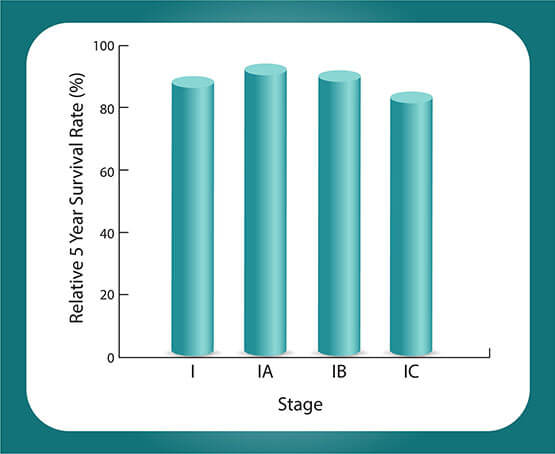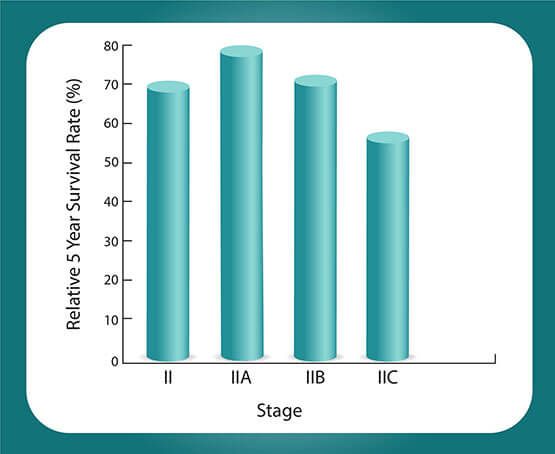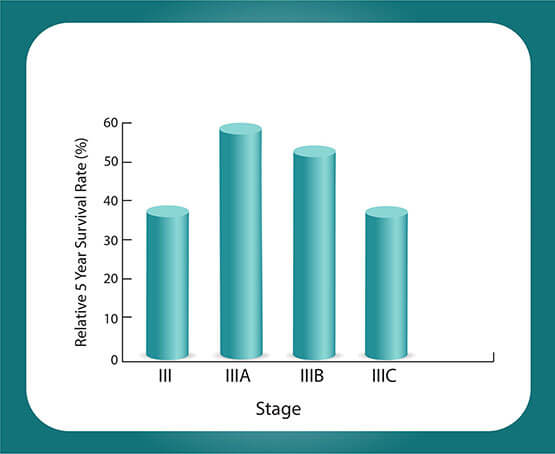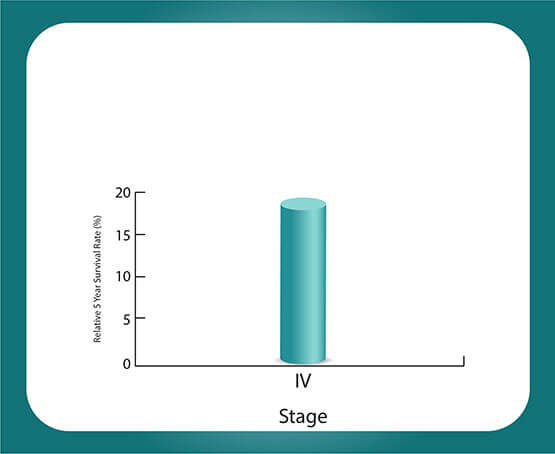Stages
Staging is the process of finding out how much cancer is in a person’s body and where it’s located. It’s how the doctor determines the stage of a person’s cancer. For most types of cancer, doctors use staging information to help plan treatment and to predict a person’s outlook (prognosis). Although each person’s situation is different, cancers with the same stage tend to have similar outlooks and are often treated the same way. The cancer stage is also a way for doctors to describe the extent of the cancer when they talk with each other about a person’s cancer.
Each of these stages, except Stage IV, is divided into A, B, and C.

Stage I
Stage I : Cancer is found in one or both ovaries:
- Stage IA: Cancer is found inside a single ovary.
- Stage IB: Cancer is found inside both ovaries
- Stage IC: Cancer is found inside one or both ovaries and one of the following is true:
- cancer is also found on the outside surface of one or both ovaries; or
- the capsule (outer covering) of the ovary has ruptured (broken open); or
- cancer cells are found in the fluid of the peritoneal cavity (the body cavity that contains most of the organs in the abdomen) or in washings of the peritoneum (tissue lining the peritoneal cavity).
15% of all cases of ovarian cancer are diagnosed with they are Stage I.
Prognosis & Survival Rates
For all types of ovarian cancer taken together, about 3 in 4 (72.4%) women with ovarian cancer live for at least 1 year after diagnosis. Almost half (46.2%) of women with ovarian cancer are still alive at least 5 years after diagnosis. Women diagnosed when they are younger than 65 do better than older women.
Most women with Stage I ovarian cancer have an excellent prognosis. Stage I patients with grade I tumors have a 5-year survival of over 90%, as do patients in stages IA and IB. Survival rates are often based on studies of large numbers of people, but they can’t predict what will happen in any particular person’s case. Other factors impact a woman’s prognosis, including her general health, the grade of the cancer, and how well the cancer responds to treatment.

Treatment
For all types of ovarian cancer taken together, about 3 in 4 (72.4%) women with ovarian cancer live for at least 1 year after diagnosis. Almost half (46.2%) of women with ovarian cancer are still alive at least 5 years after diagnosis. Women diagnosed when they are younger than 65 do better than older women.
Most women with Stage I ovarian cancer have an excellent prognosis. Stage I patients with grade I tumors have a 5-year survival of over 90%, as do patients in stages IA and IB. Survival rates are often based on studies of large numbers of people, but they can’t predict what will happen in any particular person’s case. Other factors impact a woman’s prognosis, including her general health, the grade of the cancer, and how well the cancer responds to treatment.
Stage II
Stage II: Cancer is found in one or both ovaries and has spread into other areas of the pelvis.
- Stage IIA: Cancer has spread to the uterus and/or fallopian tubes (the long slender tubes through which eggs pass from the ovaries to the uterus).
- Stage IIB: Cancer has spread to other tissue within the pelvis.
- Stage IIC: Cancer is found inside one or both ovaries and has spread to the uterus and/or fallopian tubes, or to other tissue within the pelvis. Also, one of the following is true:
- cancer is found on the outside surface of one or both ovaries; or
- the capsule( outer covering) of the ovary has ruptured (broken open); or
- cancer cells are found in the fluid of the peritoneal cavity (the body cavity that contains most of the organs in the abdomen) or in washings of the peritoneum (tissue lining the peritoneal cavity).
Stage II ovarian cancer is a small group, compromising 19% of ovarian cancer diagnoses.
Prognosis & Survival Rates
For all types of ovarian cancer taken together, about 3 in 4 women with ovarian cancer live for at least 1 year after diagnosis. Almost half (46.2%) of women with ovarian cancer are still alive at least 5 years after diagnosis. Women diagnosed when they are younger than 65 do better than older women.
Most women diagnosed with Stage II ovarian cancer have a five-year survival rate of approximately 70%. Survival rates are often based on studies of large numbers of people, but they can’t predict what will happen in any particular person’s case. Other factors impact a woman’s prognosis, including her general health, the grade of the cancer, and how well the cancer responds to treatment

Treatment
Treatment for Stage II ovarian cancer includes: hysterectomy and bilateral salpingo-oophorectomy (removal of both ovaries and fallopian tubes), debulking of as much of the tumor as possible, and sampling of lymph nodes and other tissues in the pelvis and abdomen that are suspected of harboring cancer. After the surgical procedure, treatment may be one of the following: 1) combination chemotherapy with or without radiation therapy or 2) combination chemotherapy
Stage III
Stage III: Cancer is found in one or both ovaries and has spread outside the pelvis to other parts of the abdomen and/or nearby lymph nodes. Cancer that has spread to the surface of the liver is also considered stage III ovarian cancer.
- Stage IIIA: The tumor is found in the pelvis only, but cancer cells that can be seen only with a microscope have spread to the surface of the peritoneum (tissue that lines the abdominal wall and covers most of the organs in the abdomen), the small intestines, or the tissue that connects the small intestines to the wall of the abdomen.
- Stage IIIB: Cancer has spread to the peritoneum and the cancer in the peritoneum is 2 centimeters or smaller.
- Stage IIIC: Cancer has spread to the peritoneum and the cancer in the peritoneum is larger than 2 centimeters and/or cancer has spread to lymph nodes in the abdomen.
60% of all cases of ovarian cancer are diagnosed when they are Stage III.
Prognosis & Survival Rates
For all types of ovarian cancer taken together, about 3 in 4 women with ovarian cancer live for at least 1 year after diagnosis. Almost half (46%) of women with ovarian cancer are still alive at least 5 years after diagnosis. Women diagnosed when they are younger than 65 do better than older women.
Most women diagnosed with Stage III ovarian cancer have a five-year survival rate of approximately 39%. Survival rates are often based on studies of large numbers of people, but they can’t predict what will happen in any particular person’s case. Other factors impact a woman’s prognosis, including her general health, the grade of the cancer, and how well the cancer responds to treatment.

Treatment
Treatment for Stage III ovarian cancer is the same as for Stage II ovarian cancer: hysterectomy and bilateral salpingo-oophorectomy (removal of both ovaries and fallopian tubes), debulking of as much of the tumor as possible, and sampling of lymph nodes and other tissues in the pelvis and abdomen that are suspected of harboring cancer. After surgery, the patient may either receive combination chemotherapy possibly followed by additional surgery to find and remove any remaining cancer.
Stage IV
Stage IV:In stage IV, cancer has spread beyond the abdomen to other parts of the body, such as the lungs or tissue inside the liver. Cancer cells in the fluid around the lungs is also considered stage IV ovarian cancer.
Prognosis & Survival Rates
For all types of ovarian cancer taken together, about 3 in 4 women with ovarian cancer live for at least 1 year after diagnosis. Almost half (46%) of women with ovarian cancer are still alive at least 5 years after diagnosis. Women diagnosed when they are younger than 65 do better than older women.
Most women diagnosed with Stage IV ovarian cancer have a five-year survival rate of approximately 17%. Survival rates are often based on studies of large numbers of people, but they can’t predict what will happen in any particular person’s case. Other factors impact a woman’s prognosis, including her general health, the grade of the cancer, and how well the cancer responds to treatment.

Treatment
Treatment for Stage IV ovarian cancer will consist of surgery to remove as much of the tumor as possible, followed by combination chemotherapy.